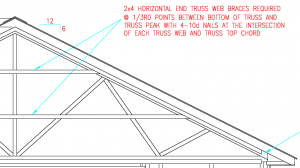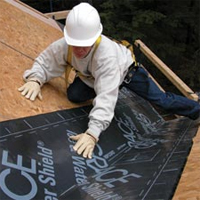Sharkskin Ultra®
Sharkskin Ultra® is a high-performance roof underlayment for all steel roofing applications over solid decking (OSB – Oriented Strand Board or plywood).
https://sharkskinroof.com/sharkskin-products/sharkskin-ultra/
Construction professionals know how important a quality roof system is. This is why so much research, time and effort goes into specifying and installing right roofing products for every home and building.
Sharkskin Ultra® is the original patented synthetic roof underlayment. Designed to ensure quality roof installations are not short changed by inferior “old technology” asphalt felts, or cheap inferior commodity based synthetic roof underlayments. Sharkskin Ultra® is the heaviest, most robust, mechanically fastened polypropylene polymer based product commercially available. Its industry leading high-tensile strength provides the highest tested wind resistance and 12-UV rating available.
Sharkskin Ultra® has a unique patented design using multiple layers of blended polypropylene to achieve:
High tensile strength for durable secondary moisture protection (face it – if water somehow gets through a properly installed steel roofing application, you really do not want it going any further). Plus, if your primary roofing is blown off, it provides a secure secondary water barrier.
High traction non-slip surface for excellent grip and safe walking, even in wet or dusty conditions. Obviously, always use caution and fall protective gear especially in wet weather and windy conditions. There are few things more terrifying than butterflies in one’s stomach as you slide down a roof towards eave edge. In 1988 my Dad was killed in a construction fall off a roof, so I am very sensitive to this one.
Weighing only 50 pounds per 10 square roll (48” x 250’), its light weight makes for faster installations and reduces dead loads on roof systems.
12 months UV resistance, providing long term protection under protracted roofing installations.
ICC-ES, Miami Dade and Florida Building Code approved.
Performs in all temperatures from -40 to 280 degrees F. (Fahrenheit), making it perfect for steel roof installations.
Light grey surface is cooler for installers to work with and walk over than black asphalt impregnated felt. Can be easily marked with a crayon and holds chalk line markings. AS it will not scar or melt, there is no sticky mess like with asphalt impregnated felt (tar paper).
Installs with 3/8” roofing nails, no cap nails required and provides long term nail seal-ability per ICC-ES AC48.
Comes with a manufacturer’s 50-year warranty.
Considering steel roofing over a solid sheathed roof deck? If so, Sharkskin Ultra® might be a design solution to be considered.

 While every manufacturer will vary just a bit, but all require same underlayment procedure for roofs below 4 in 12 pitch. You have really two choices. First recommended choice would be installing two layers of 15 pound asphalt saturated roofing felt with lap seams offset from one another and all lap seams embedded in asphalt cement. A second choice – install an ice and water membrane throughout entire roof beneath roofing.
While every manufacturer will vary just a bit, but all require same underlayment procedure for roofs below 4 in 12 pitch. You have really two choices. First recommended choice would be installing two layers of 15 pound asphalt saturated roofing felt with lap seams offset from one another and all lap seams embedded in asphalt cement. A second choice – install an ice and water membrane throughout entire roof beneath roofing.





